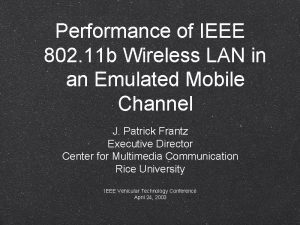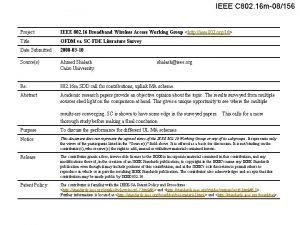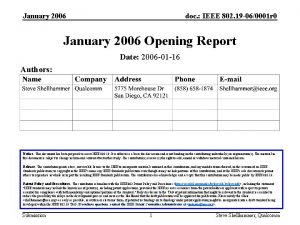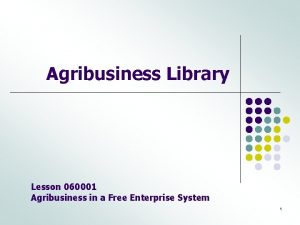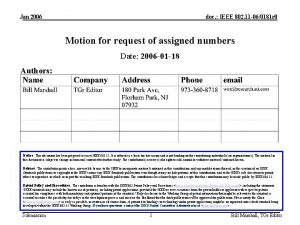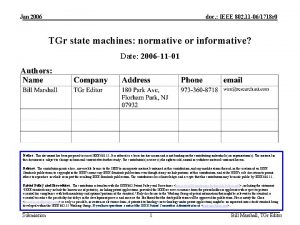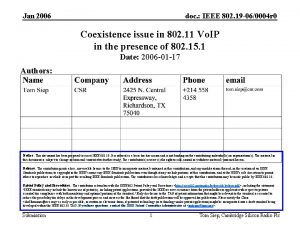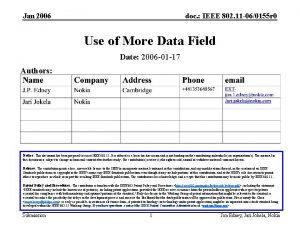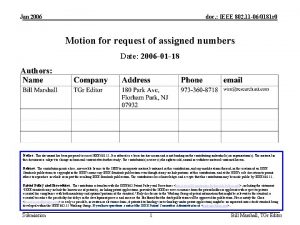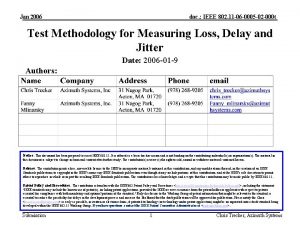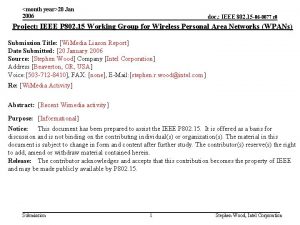Jan 2006 doc IEEE 802 11 060001 r













- Slides: 13

Jan 2006 doc. : IEEE 802. 11 -06/0001 r 1 ESS Load Balancing Authors: Date: 2006 -01 -06 Notice: This document has been prepared to assist IEEE 802. 11. It is offered as a basis for discussion and is not binding on the contributing individual(s) or organization(s). The material in this document is subject to change in form and content after further study. The contributor(s) reserve(s) the right to add, amend or withdraw material contained herein. Release: The contributor grants a free, irrevocable license to the IEEE to incorporate material contained in this contribution, and any modifications thereof, in the creation of an IEEE Standards publication; to copyright in the IEEE’s name any IEEE Standards publication even though it may include portions of this contribution; and at the IEEE’s sole discretion to permit others to reproduce in whole or in part the resulting IEEE Standards publication. The contributor also acknowledges and accepts that this contribution may be made public by IEEE 802. 11. Patent Policy and Procedures: The contributor is familiar with the IEEE 802 Patent Policy and Procedures <http: // ieee 802. org/guides/bylaws/sb-bylaws. pdf>, including the statement "IEEE standards may include the known use of patent(s), including patent applications, provided the IEEE receives assurance from the patent holder or applicant with respect to patents essential for compliance with both mandatory and optional portions of the standard. " Early disclosure to the Working Group of patent information that might be relevant to the standard is essential to reduce the possibility for delays in the development process and increase the likelihood that the draft publication will be approved for publication. Please notify the Chair <stuart. kerry@philips. com> as early as possible, in written or electronic form, if patented technology (or technology under patent application) might be incorporated into a draft standard being developed within the IEEE 802. 11 Working Group. If you have questions, contact the IEEE Patent Committee Administrator at <patcom@ieee. org>. Submission 1 Bin Wang, ZTE Corporation

Jan 2006 doc. : IEEE 802. 11 -06/0001 r 1 Abstract This document suggests ESS load balancing for Wireless Network Managements. Submission 2 Bin Wang, ZTE Corporation

Jan 2006 doc. : IEEE 802. 11 -06/0001 r 1 Agenda • • • Submission Definition The classification of load balancing Neighbor Load Balancing step ESS Load Balancing step 3 Bin Wang, ZTE Corporation

Jan 2006 doc. : IEEE 802. 11 -06/0001 r 1 Definition • dot 11 Load. Difference : – defined the threshold of two AP’s load difference to init a load balancing process. • The necessity of load difference: – Load balancing adjust process would bring new network overhead into the ESS. – Limit the frequency of load distribution process, decrease network management exchange between AP and STA, decrease network overhead. – Avoid frequent handover caused by load balancing. – Can be changed adaptively by other function such as frequent handover avoid. Submission 4 Bin Wang, ZTE Corporation

Jan 2006 doc. : IEEE 802. 11 -06/0001 r 1 The classification of load balancing • Load balancing should be divided into two sections. • Neighbor Load balancing. – deal with the problem of load difference among neighbor APs • ESS load balancing. – deal with the problem of load difference in ESS which has more APs beyond neighbor scope. Submission 5 Bin Wang, ZTE Corporation

Jan 2006 doc. : IEEE 802. 11 -06/0001 r 1 Neighbor Load Balancing Submission 6 Bin Wang, ZTE Corporation

Jan 2006 doc. : IEEE 802. 11 -06/0001 r 1 Neighbor Load Balancing • AP will give it’s STA some candidate information for handover, reduce the sightless handover of STA in advance. – Suppose the dot 11 Load. Difference is set to (30). As showing in figure, AP 7, 2, 5, 6 should be excellent candidates subject to AP 4. • Because the STA of central AP can not or has very little possibility to handover to the other AP in one step which are not adjacent to the central AP. • Tiny scope adjust to solve neighbor scope problems. Submission 7 Bin Wang, ZTE Corporation

Jan 2006 doc. : IEEE 802. 11 -06/0001 r 1 Neighbor Load Balancing step • 1. Load difference discovery. – Each AP in ESS exchange load information with it’s neighbor AP, when the central AP discovery the existence of load difference and the difference has been greater than dot 11 Load. Difference,Then the AP would init a load balance process. • 2. AP implements the candidate neighbor information exchanging – The central AP should select one or more candidates from neighbor APs based on the candidate neighbor selection algorithm, and format to a candidate list, send to the STAs belongs to the central AP. – The detail frame format and interactive sequence should be same as the description in document “ 11 -05 -1064 -00 -000 v-normativetext-proposal-load-balancing. doc” Submission 8 Bin Wang, ZTE Corporation

Jan 2006 doc. : IEEE 802. 11 -06/0001 r 1 Neighbor Load Balancing step • 3. STA makes roaming decision. – The detail frame format and interactive sequence should be same as the description in document “ 11 -05 -1064 -00 -000 v-normativetext-proposal-load-balancing. doc”. Submission 9 Bin Wang, ZTE Corporation

Jan 2006 doc. : IEEE 802. 11 -06/0001 r 1 ESS Load Balancing Submission 10 Bin Wang, ZTE Corporation

Jan 2006 doc. : IEEE 802. 11 -06/0001 r 1 ESS Load Balancing • Suppose the dot 11 Load. Difference is set to (30). The load of ESS is distributed in gradate by position, as showing in the figure: – The load difference between AP 1 and it’s neighbors (AP 2, 3, 4) are all less than the threshold. – The load difference between any two APs are less than the threshold. – But the difference between AP 1 and AP 5, 6 are greater than the threshold, and the unbalancing do existed. – In this circumstance, the Neighbor Load Balancing will never started and this kind of unbalancing will keep living. • The AP 1 should try to pass it’s load to the AP 5 or AP 6, which are beyond the scope of neighbor of AP 1. • Pass Load Process is necessary. Submission 11 Bin Wang, ZTE Corporation

Jan 2006 doc. : IEEE 802. 11 -06/0001 r 1 ESS Load Balancing step • 1. Candidate AP select and create candidate list. – After the heavy load AP init a load balancing process, it should select candidate target AP in the ESS, whether the candidate is in the neighbor position of the heavy load AP or not. • 2. Pass load to the light AP. – The heavy load AP should try to pass it’s load to the lightest AP or the AP in the direction. Each pass process has a time expire, after the pass process, the heavy AP would calculate success rate. if the success rate of once load pass process below some threshold, a newer target will be selected. – The load pass process would be marked in the target AP, and after the pass process, this target AP would try to init a new Neighbor Load Balancing and try to pass it’s load to the lighter direction. – The pass load process will be terminated only if the candidate list has been consumed or the load of the heavy AP has been successful passed. Submission 12 Bin Wang, ZTE Corporation

Jan 2006 doc. : IEEE 802. 11 -06/0001 r 1 Feedback? Submission 13 Bin Wang, ZTE Corporation











